| FEATURE | HOW TO ADJUST | ILLUSTRATION (generic) |
Seatpan Height Does the chairís seatpan height adjust up and down? Back to Top | Look for a paddle lever. Seated in the chair pull on the lever to adjust the height. Lower the seatpan all the way down and then raise it all the way up by taking a little weight of off the seatpan. Make sure it works correctly. For now adjust it so your feet are flat on the floor. Later you will need to adjust it based on your worksurface set-up. | 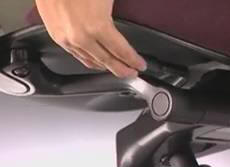 |
Seatpan Tilt Does the chairís seatpan tilt up and down? Back to Top | Look for a paddle lever. If the chair has one, adjust it to tilt it all the way one and then the other way to make sure it works. For now adjust it so the seatpan is flat (parallel with the floor). | 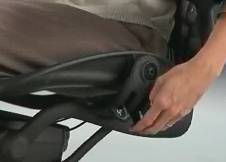 |
Seatpan Depth Does the chairís seat move forward or backward? Back to Top | Look for a lever under seat. You may not have this adjustment. If you do, sit all the way back in the chair and adjust the seat so you have 2 to 3Ē behind the back of the knee and front of the chair. Always avoid pressure behind the knee caused by contact with the front of the chair. NOTE: If you have contact between the back of the knee and front of the seatpan the seatpan is not the correct size and should be replaced. | 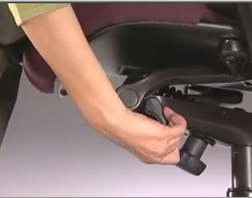 |
Seatpan Fit Does the chairís seat fit your body size? Back to Top | Chair seat size needs to comfortably accommodate your hips and thighs in terms of width and depth. Allow 1 to 2Ē on each side. Either too much or too little distance indicates a problem. NOTE: A NO answer indicates the chair is not the correct size and should be replaced. | 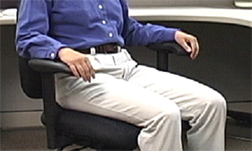 |
Casters Does the chair roll easily on the floor surface? Back to Top | To roll easily and safely you should have hard plastic casters on carpet, softer rubberized casters on tile. Also look for damaged or worn flooring that may limit mobility. NOTE: A NO answer indicates the casters should be replaced or a chair mat should be used. | 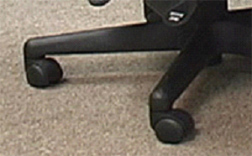 |
Seatpan Tension Can you adjust the seatpan tension. Back to Top | Look for a knob under the chair. Turn it clockwise to tighten and counterclockwise to loosen. How much is based on body weight - you want enough tension to provide support when you rock back but not so much it launches you out of the chair! NOTE: With the tension as tight as it goes if you still do not have adequate support the chair should be replaced. | 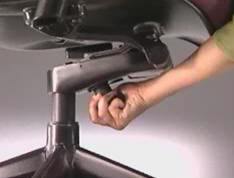 |
Back Support Height Does your chairís back support move up and down? Back to Top | To adjust back support look for: Knob where the back support attaches to the chair Lever on the back support to released the lock If no knobs or levers exist pull up on the back support, if it moves easily pull it all the way up and then let it all the way down AND then pull it up one notch at a time to adjust it.
Move the back support all the way up and down to ensure it works. Position the back rest to accommodate the natural curves of your spine. NOTE: if you can not obtain proper back support the chair should be replaced. | 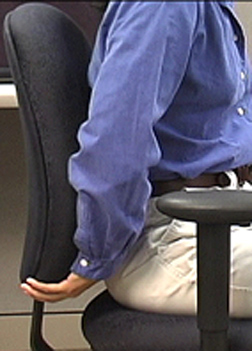 |
Back Support Angle Does your chairís back rest angle forward or backward? Back to Top | Look for a paddle lever. Pull up on the lever to angle the back support all the way from upright to angled back to make sure it works. Adjust it to sit upright in the chair. NOTE: if you can not obtain proper back support the chair should be replaced. | 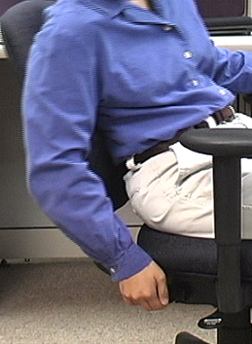 |
Armrests Adjust Do your chairís armrests adjust up and down and/or side-to-side? Back to Top | Look for a control on the armrest. Move the armrests all the way up and down and/or side-to-side to ensure they work. Adjust them so they support your elbows with your shoulders in a comfortable position. NOTE: if you can not obtain proper arm support the armrests should be replaced or a different chair obtained. | 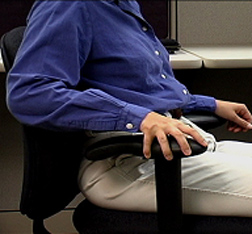 |
Maintenance Is your chair functioning properly (no maintenance problems)? Back to Top | A chair with maintenance problems is a safety hazard. Make sure you report any maintenance problems. NOTE: A NO answer indicates the chair should be replaced or repaired. | 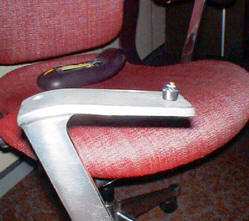 |
Chair Checklist Corrective Action Summary |
| Your chair may not have all of the adjustment features listed and still be a suitable chair for you. Summarize your findings in the chart below and take the Corrective Action as indicated. (print Chair Checklist) |
| Feature | Issue | Corrective Action |
| Seatpan Height | Yes | No | Based on workstation setup if chair can not be appropriately adjusted it should be replaced. |
| Seatpan Tilt | Yes | No | Based on workstation setup if chair can not be appropriately adjusted it should be replaced. |
Seatpan Depth | Yes | No | Seatpan is not the correct size and should be replaced. |
Seatpan Fit | Yes | No | Chair is not the correct size and should be replaced. |
| Casters | Yes | No | Casters should be replaced or a chair mat should be used. |
Seatpan Tension | Yes | No | Chair should be replaced. |
Back Support Height | Yes | No | Chair should be replaced. |
Back Support Angle | Yes | No | Chair should be replaced. |
Armrests | Yes | No | Armrests should be replaced or a different chair obtained. |
| Maintenance | Yes | No | Chair should be replaced or repaired. |